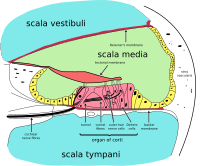
Photo from wikipedia
OBJECTIVES This study aimed to determine vestibular involvement in patients with auditory neuropathy (AN) using ocular vestibular evoked myogenic potential (oVEMP), cervical vestibular evoked myogenic potential (cVEMP), caloric tests, video… Click to show full abstract
OBJECTIVES This study aimed to determine vestibular involvement in patients with auditory neuropathy (AN) using ocular vestibular evoked myogenic potential (oVEMP), cervical vestibular evoked myogenic potential (cVEMP), caloric tests, video Head Impulse Tests (vHIT), and Suppression Head Impulse Paradigm (SHIMP) tests. METHODS Twenty-two patients with AN (study group) and 50 age-and-gender-matched healthy subjects (control group) were enrolled. All patients underwent air-conducted sound oVEMP and cVEMP tests. In the study group, 20 patients underwent a caloric test, 10 patients underwent a video Head Impulse Test (vHIT), and nine patients underwent the Suppression Head Impulse Paradigm (SHIMP) test. RESULTS Significant differences in VEMP abnormalities were found between the two groups. Most AN patients showed no VEMP response, while only a few patients showed VEMP responses with normal parameters. Some AN patients presented abnormal VEMP parameters, including thresholds, latencies, and amplitudes. The abnormal rate (including no response and abnormal parameters) was 91% in the cVEMP test and 86% in the oVEMP test. No significant difference was found between oVEMP and cVEMP abnormalities. AN patients exhibited a 70% abnormal rate in the caloric test. Most AN patients showed normal VOR gains. Most patients showed no overt corrective saccades in vHIT, and exhibited normal anticompensatory saccades in the SHIMP test. CONCLUSION Many AN patients experience vestibular dysfunction, which may be detected by using a vestibular functional test battery. SIGNIFICANCE VEMP abnormalities might reflect the status and degree of vestibular involvement in AN.
Journal Title: Clinical Neurophysiology
Year Published: 2020
Link to full text (if available)
Share on Social Media: Sign Up to like & get
recommendations!